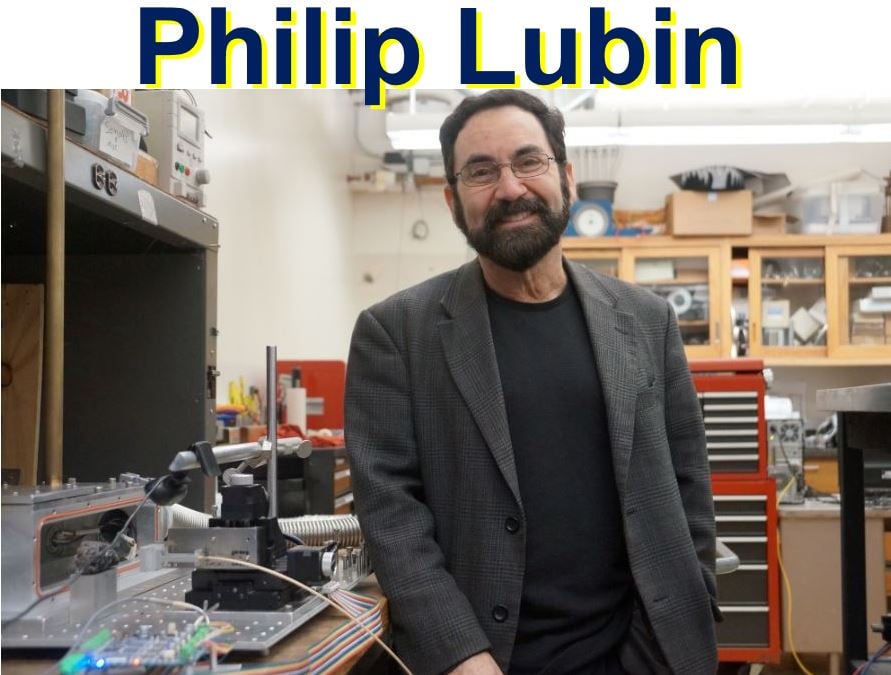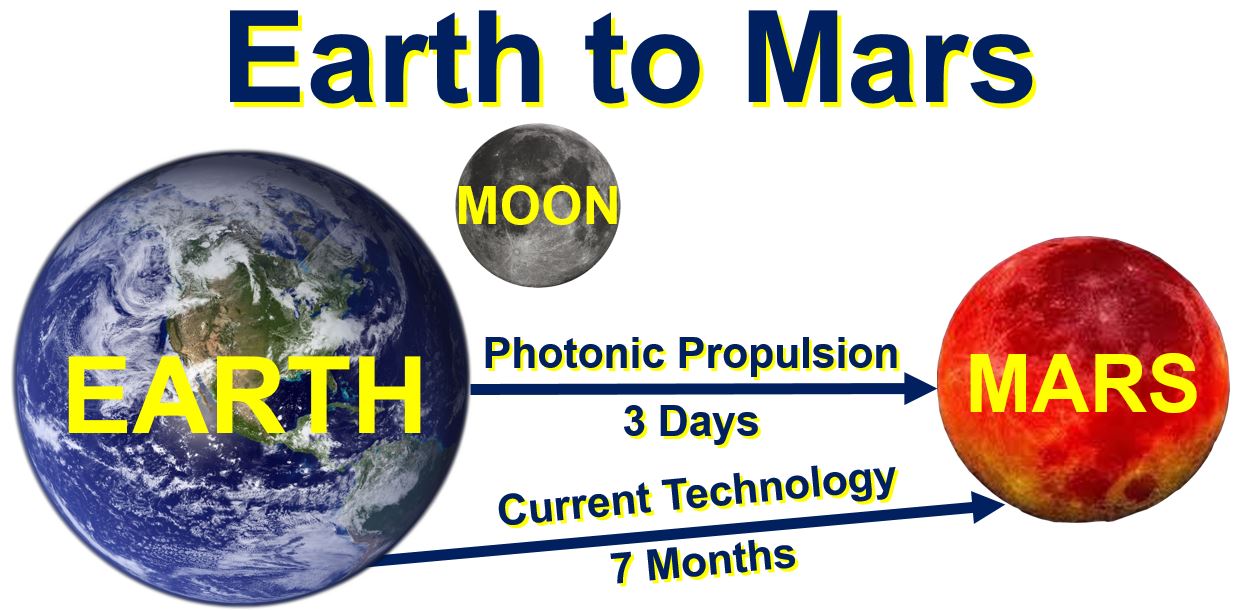An Earth to Mars manned mission could take just 3 days to get to the Red Planet with photonic propulsion technology, which uses lasers as a means to propel a spacecraft, says a group of scientists at the University of California, Santa Barbara (UCSB).
The system works a bit like a sailing boat, but instead of wind hitting the sails, laser beams strike the spacecraft’s sail and push it forwards.
At the moment, the UCSB’s Experimental Cosmology Group, which is working on the Directed Energy Interstellar Precursors (Deep-In) programme, is creating tiny experimental probes to see whether laser-driven photonic propulsion is a viable option for high-speed space travel.
 An artistic rendition of a laser hitting the spaceship’s sail (large dark disk). The light hitting the sail pushes the craft forward, until it reaches a very high speed. (Image: deepspace.ucsb.edu)
An artistic rendition of a laser hitting the spaceship’s sail (large dark disk). The light hitting the sail pushes the craft forward, until it reaches a very high speed. (Image: deepspace.ucsb.edu)
Photonic propulsion trials with small objects
Team leader, Philip Lubin, Professor of Physics at UCSB, and colleagues say we could eventually create a larger craft for transporting humans if the initial research and tests on the small probes go well.
Prof. Lubin says that if we are serious about interstellar travel – travelling outside our solar system – we will need spacecraft with considerably faster speeds than the ones we use today.
NASA quoted Prof. Lubin this month as saying:
“We propose a system that will allow us to take a significant step towards interstellar exploration using directed energy propulsion combined with wafer scale spacecraft.”
“One of NASA’s goals and one of humanity’s grand challenges is to explore other planetary systems by remote sensing, sending probes, and eventually life to explore. This is a long standing and difficult to implement dream. The technological challenges are formidable.”
 Professor Philip Lubin standing next to the laser his lab uses to conduct experiments. (Image: news.ucsb.edu)
Professor Philip Lubin standing next to the laser his lab uses to conduct experiments. (Image: news.ucsb.edu)
“A step in this direction is to send small probes that will supplement the current long range remote sensing done by orbital telescopes.”
At Nasa’s National Innovative Advanced Concepts (Niac) symposium, Prof. Lubin explained that *relativistic speeds are attained by his team in the lab all the time. But when we go to macroscopic levels (bigger sizes), things like cars, spacecraft, and airplanes are ‘pathetically slow’.
* A relativistic speed is a velocity which is a significant proportion of the speed of light. Most scientists set the minimum relativistic speed at 10% the speed of light (when Newtonian mechanics no longer provide an accurate description of a particle).
Getting larger crafts to move faster
The Experimental Cosmology Group aims to bridge the gap between tiny things – that we can propel ultra-fast – and large crafts, using photonic propulsion technology.
In theory, this is a simple procedure – a spacecraft would be propelled forward by the thrust from photons (particles of light) emitted from a laser array.
Every spacecraft moves by firing its propellant in the opposite direction to the way it wants to travel – fire the propellant behind you and you move forward, fire it in front of you and you move backward.
Current spaceships use fuel as their propellant, which have to be carried in large quantities, making the spacecraft heavier.
 Photonic propulsion would drastically reduce the time it takes to travel to Mars.
Photonic propulsion would drastically reduce the time it takes to travel to Mars.
The advantage of photonic propulsion is that it does not add to the mass of the spaceship, because the beams of light are emitted from elsewhere. This means it can accelerate rapidly, because it is very light (less fuel to carry) and is able to reach greater speeds.
Scientists say the same technology could be used to get airplanes flying at considerably faster velocities.
Could spaceships fly at one-quarter light speed?
While not specifying how fast he sees spacecraft in the near future travelling thanks to photonic propulsion, he mentioned that perhaps up to one quarter of the speed of light might be possible.
Light travels at about 670 million miles per hour, so one quarter of that would be approximately 167 million miles per hour.
With photonic propulsion, Prof. Lubin believes he and his team could propel a 100kg craft to Mars in a few days, compared to a shuttle (Nasa’s Space Launch System) that would take months to get there.
Nasa’s Space Launch System (SLS) will be built in 2018 and will launch astronauts in its Orion spacecraft on missions to an asteroid that will have been placed in orbit around the Moon. This will be in preparation for a future Mars mission.
 Proxima Centauri, our nearest star (apart from the Sun), is 4.24 light years away. If photonic propulsion got our spaceships to travel at one quarter the speed of light, it would take just under 17 years to get there. Voyager 1, travelling at 17.05 kilometres per second, our fastest spacecraft ever built, would take 70,000 years to get there. (Image: Wikipedia)
Proxima Centauri, our nearest star (apart from the Sun), is 4.24 light years away. If photonic propulsion got our spaceships to travel at one quarter the speed of light, it would take just under 17 years to get there. Voyager 1, travelling at 17.05 kilometres per second, our fastest spacecraft ever built, would take 70,000 years to get there. (Image: Wikipedia)
Interstellar travel will be possible
The Experimental Cosmology Group explains that since the birth of spaceflight, we have accomplished remarkable feats of exploration and showcased our drive to understand the Universe.
However, during spaceflight’s 60 life, only one spacecraft – Voyager 1, which was launched in 1977 – has managed to leave our solar system.
We may view Voyager 1 as a fantastic achievement, but we will never reach even the nearest star with the propulsion technology we have today. We need radically new strategies with the technology already available.
The Experimental Cosmology Group says it has a roadmap to a programme that will give our spaceships and probes relativistic speeds so that we can get to the nearest stars.
The Group wrote, regarding our thinking of what propulsion is:
“To do so requires a fundamental change in our thinking of both propulsion and our definition of what a spacecraft is. In addition to larger spacecraft capable of human transportation, we consider “wafer sats”, wafer-scale systems weighing no more than a gram.”
“The wafer sats would include integrated optical communications, optical systems, and sensors. These crafts, combined with directed energy propulsion, could be capable of speeds greater than ¼ c.”
The Group believes its programme has applications for Kepler and SETI missions, as well as planetary defense.
Video – Prof. Lubin talks about photonic propulsion
A talk given by Prof. Lubin about the Directed EnErgy Propulsion for Interstellar exploratioN (DEEP-IN) project given on October 28, 2015 at the NASA NIAC Fall Symposium in Seattle, WA.
